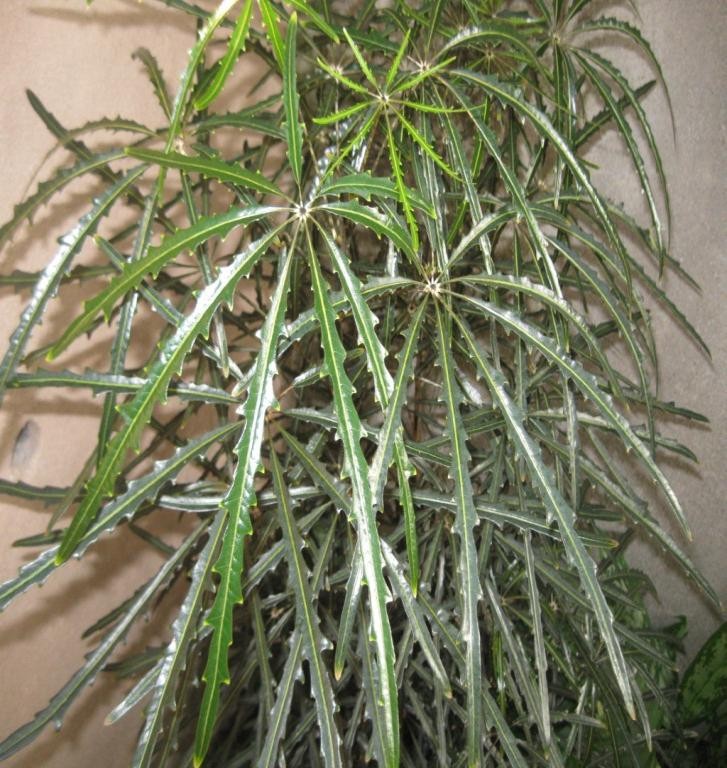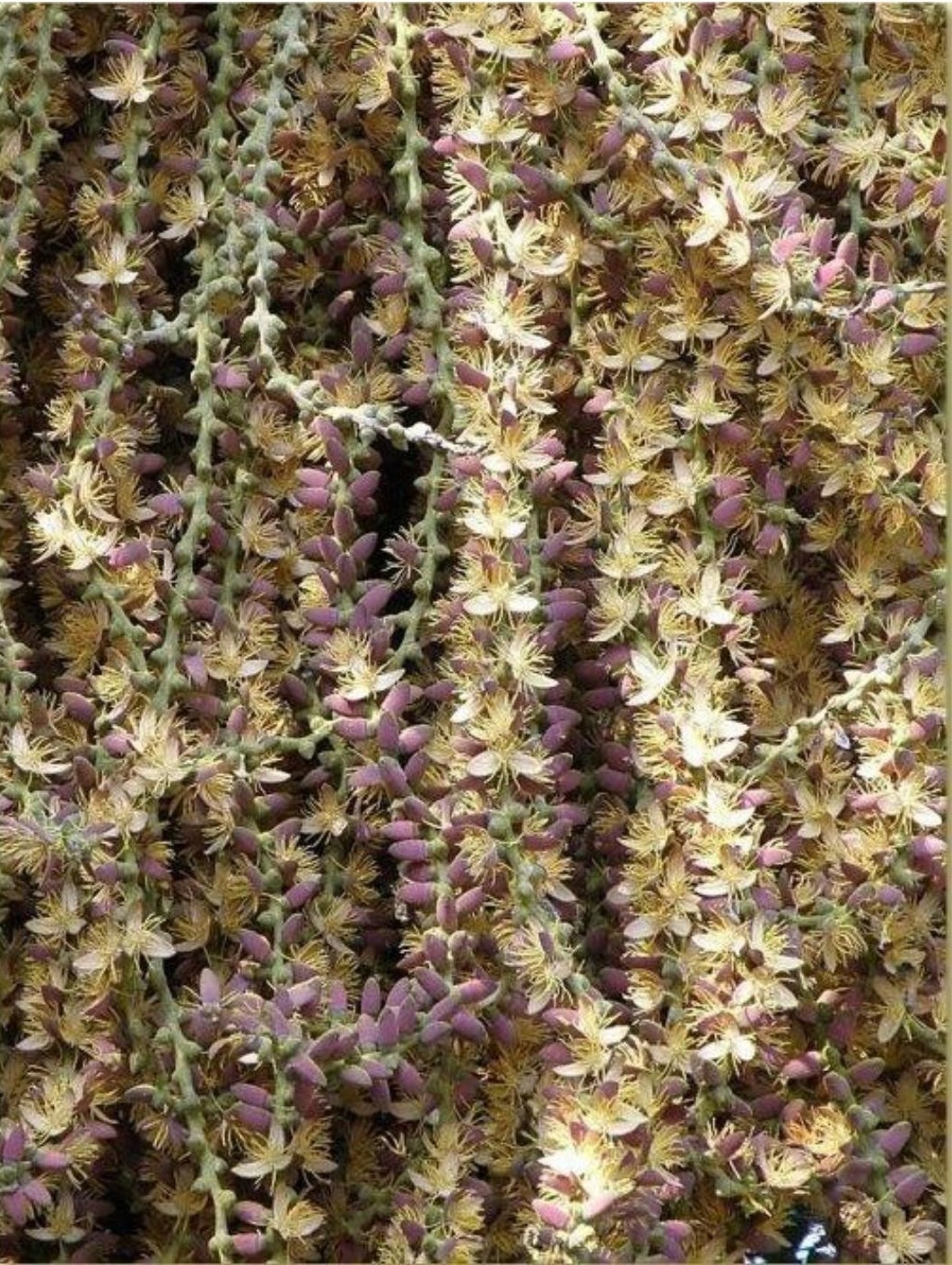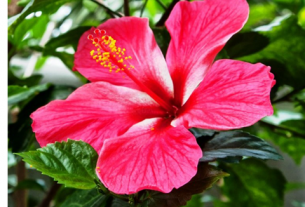By Tommy Clarkson from the August 2016 Edition
Family: Araceae
Also known as Red Leaf Philodendron, Blushing Philodendron, Burgundy Philodendron, Red Emerald 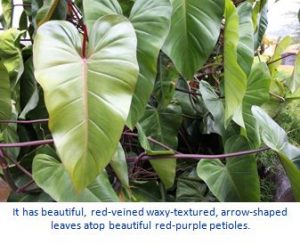 Philodendron, Sweetheart Plant and various other hybrid names.
Philodendron, Sweetheart Plant and various other hybrid names.
(This is really a simply delightful, good looker. Ours happily sits on the Sunrise Terrace with indirect sun all day long, basking in the complimentary comments it elicits!)
Etymology first. “Philodendron” is a composite of two Greek words “phileo” meaning love and “dendron” for tree. Combined, they well describe this family of plants that cling, clutch and climb trees even better than did we as kids.
Erubescens, a Greek word, describes something that blushes or turns red.
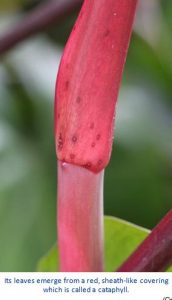 Philodendrons belong to the Arums or Aroid family which is characterized by distinctive spathe-and-spadix blooms but don’t expect such from your Red Philodendron.
Philodendrons belong to the Arums or Aroid family which is characterized by distinctive spathe-and-spadix blooms but don’t expect such from your Red Philodendron.
Estimates vary wildly as to how many different species there are in the Philodendron family from as low as 350 to twice that at 700. These are spread throughout tropical America.
Most all of these evergreens have large to immense leaves and, often, colorful flowers. Most prefer shade to partial sun, are water lovers, need rich, humusy, and (how in the world did you ever guess that this next phrase was coming) well draining soil. Propagation of most is best done through cuttings.
First identified by its botanical name in 1854, the Philodendron erubescens is native to Costa Rica and Columbia. It’s in my opinion correctly touted by no few as the “loveliest in the genus.”
As it roots at the stem node, it is a vigorous climber/creeper that fairly scrambles up trees and spreads over 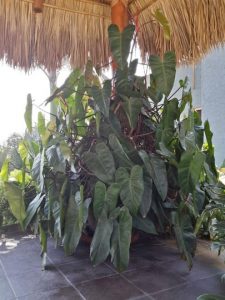 the ground. A dexterous and multitalented sort, don’t be surprised to look up and see it thriving high in the trees as an epiphyte if its connections to the ground have, somehow, been severed.
the ground. A dexterous and multitalented sort, don’t be surprised to look up and see it thriving high in the trees as an epiphyte if its connections to the ground have, somehow, been severed.
It has beautiful, one foot (30.48 cm) long, waxy textured, arrow shaped leaves. These are on top of strikingly beautiful red petioles that are as long and sometimes even longer than the leaf blades (the broad portion of a leaf). All of its new leaves emerge from a sheath like covering which is called a cataphyll.
Riffle succinctly and absolutely correctly described the leaf coloration, as follows, “Young leaf color is a vivid wine-red, which matures to a deep olive green with bronze overtones and a narrow red margin.”
In shady locales, in its native, wet rain forest environs, Philodendron erubescens may well climb to sixty feet (18.29 meters). In “captivity” it may be more inclined to an average height of only twelve feet (3.66 meters) or so.
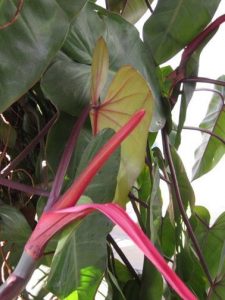 While blooms on the Red Philodendron are few and far between, keep an eye out for them. Each flower consists of a white bulb and a dark redpurple spathe.
While blooms on the Red Philodendron are few and far between, keep an eye out for them. Each flower consists of a white bulb and a dark redpurple spathe.
The Red Philodendron is a rather commonly known foliage houseplant often incorporated in interior landscape plantings for offices, lobbies or shopping malls. The plants do well if kept consistently warm 65 degrees F (18.33 C) at the absolute minimum moderately moist, and out of direct sunlight.
Nothing ever seems to be perfect however. Its sap is poisonous, can cause skin irritation if in contact with skin and, if consumed, it will cause irritation to the mouth, lips, throat and tongue. Not a pleasant experience for any of us! And as concerns our four footed pals, most philodendron are considered poisonous to our domestic animals. So if you’ve a dog or cat that tends to gnaw on things, this may well not be the species for you.
Health-wise for the plant, few pests or diseases, generally, attack the Philodendrons, however, watch for fungal problems to include dasheen mosaic virus, scale, root rot, as well as fungal and bacterial leaf spots. Creepy crawlers may include mealy bugs, scale insects, and spider mites.
A couple of very eye-catching cultivars are the Philodendron erubescens ‘Burgundy’ and the Philodendron erubescens‘Golden Erubescens’. The first has deep, winered leaves at maturity. The latter’s mature leaves are pinkish orange to pinkish yellow. But a few of some of the other great looking hybrids include the Autumn, Black Cardinal, Congo, Imperial Green, Imperial Red, Moonlight, Red Emerald and Red Princess.
(Lastly, Philodendrons are on NASA’s list of clean air plants as they help filter from the air harmful chemicals such as Ammonia, Benzene, Formaldehyde, Toluene, Trichloroethylene and Xylene. If one is absolutely exacting and outright anal retentive, I believe the recommendation is to use one plant per 100 square feet (30.48 meters) of living space in order to most effectively help filter out such undesirable airborne chemicals!)
Download the full edition or view it online
—
Tommy Clarkson is a bit of a renaissance man. He’s lived and worked in locales as disparate as the 1.2 square mile island of Kwajalein to war-torn Iraq, from aboard he and Patty’s boat berthed out of Sea Bright, NJ to Thailand, Germany, Hawaii and Viet Nam; He’s taught classes and courses on creative writing and mass communications from the elementary grades to graduate level; He’s spoken to a wide array of meetings, conferences and assemblages on topics as varied as Buddhism, strategic marketing and tropical plants; In the latter category he and Patty’s recently book, “The Civilized Jungle” – written for the lay gardener – has been heralded as “the best tropical plant book in the last ten years”; And, according to Trip Advisor, their spectacular tropical creation – Ola Brisa Gardens – is the “Number One Tour destination in Manzanillo”.


